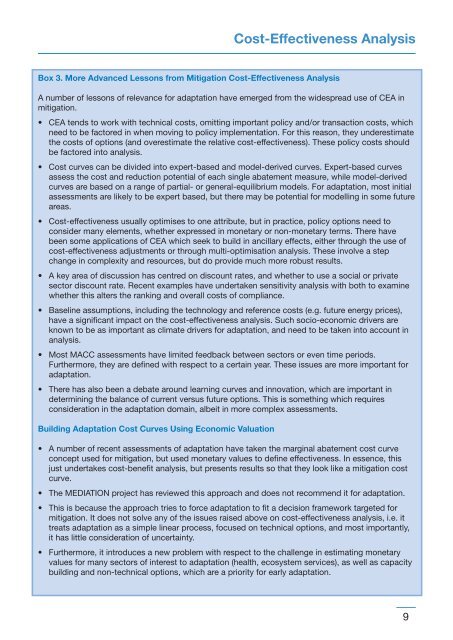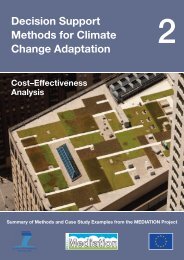DecisionSupport 2Discussion and ApplicabilityThe review and case studies provide a number ofpractical lessons on the application of costeffectivenessanalysis to adaptation. Theyprovide useful <strong>in</strong>formation on the types ofadaptation problem types where CEA might beappropriate, as well as data needs, resourcerequirements and good practice.CEA is considered most useful for near-termadaptation assessment, particularly for identify<strong>in</strong>glow and no regret options. The approach can beapplied to both market and non-market sectors,but it particularly relevant for areas that aredifficult to value <strong>in</strong> monetary terms, e.g.biodiversity, health. The use for long-termassessment is considered most appropriate whenused as part of an iterative adaptive managementanalysis, rather than as a tool on its own.It is most applicable (and relevant) where there isa clear headl<strong>in</strong>e <strong>in</strong>dicator and a dom<strong>in</strong>ant impact– and less applicable for cross sectoral andcomplex risks, because it works with a s<strong>in</strong>glemetric. It is thus more applicable when there isalready agreement on sectoral objectives andeffectiveness criteria. It is more appropriatewhere climate uncerta<strong>in</strong>ty is low, and good dataexists for cost/benefit components.The key data <strong>in</strong>puts vary on the use of the tool, i.e.whether a cost-effectiveness rank<strong>in</strong>g (cost per unitbenefit) or a full policy analysis. An <strong>in</strong>itial rank<strong>in</strong>g ofoptions can often work with generic data onburdens to identify promis<strong>in</strong>g options. However, afull policy analysis usu<strong>all</strong>y requires some form ofscenario-based impact outputs, to assess uniteffectiveness accurately, and total effectivenessaga<strong>in</strong>st a basel<strong>in</strong>e. Full cost data is needed (capitaland operat<strong>in</strong>g costs, expressed <strong>in</strong> equivalenteconomic terms) as well as data on uniteffectiveness. For policy applications, additional<strong>in</strong>formation is needed <strong>in</strong> the form of basel<strong>in</strong>e risksand the total potential for each option.In consider<strong>in</strong>g the application of CEA toadaptation, a number of good practice lessonsare highlighted:• A good start<strong>in</strong>g po<strong>in</strong>t for an adaptation CEA isto consider the cost-effectiveness of optionsto current climate variability, and then toassess cost-effectiveness <strong>in</strong> a number ofdef<strong>in</strong>ed future periods.• The application of CEA to adaptation willide<strong>all</strong>y be context and location specific. It isimportant to identify appropriate sector andrisk specific metrics, and stakeholderconsultation can help this step.• The application of CEA to adaptation shouldconsider non-technical options and capacitybuild<strong>in</strong>g as well as technical options, not<strong>in</strong>gthese are more difficult to quantify.• The application of CEA to adaptation needs toconsider uncerta<strong>in</strong>ty. This should <strong>in</strong>volve asampl<strong>in</strong>g (multiple cost curves) across a rangeof socio-economic and climate modelprojections (even if low/high ranges). The use ofs<strong>in</strong>gle central estimates and s<strong>in</strong>gle cost curvesshould be avoided. To capture the issues oftim<strong>in</strong>g and dependencies, analysis is likely torequire a m<strong>in</strong>imum of two future time periods.• The CEA basel<strong>in</strong>e should take account ofcurrent conditions and exist<strong>in</strong>g and plannedpolicy. Future basel<strong>in</strong>e projections shouldconsider socio-economic as well as climatechange, and ide<strong>all</strong>y autonomous adaptationand exist<strong>in</strong>g/planned adaptation measures.• The analysis of <strong>in</strong>ter-dependencies betweenoptions is important, i.e. how one optionmight affect another. It is also preferable toundertake CEA with<strong>in</strong> an iterative plan, tocapture enabl<strong>in</strong>g steps and portfolios ofoptions, rather than us<strong>in</strong>g outputs as a simpletechnical prioritisation.• Due to the focus on a s<strong>in</strong>gle metric, there is aneed to assess wider attributes of options, i.e.their wider environmental, social andeconomic characteristics, as well practicality,acceptability, etc. These should alter therank<strong>in</strong>g of options.• Recent applications of CEA have tried to applythe cost curve concept to adaptation us<strong>in</strong>g fullcost-benefit analysis. The MEDIATION reviewdoes not recommend such an approach. Moredetails are provided <strong>in</strong> the box.F<strong>in</strong><strong>all</strong>y, due to the widespread application of costeffectivenessanalysis <strong>in</strong> the mitigation doma<strong>in</strong>,some more advanced lessons have beenidentified. These are summarised <strong>in</strong> the box.8
Cost-Effectiveness AnalysisBox 3. More Advanced Lessons from Mitigation Cost-Effectiveness AnalysisA number of lessons of relevance for adaptation have emerged from the widespread use of CEA <strong>in</strong>mitigation.• CEA tends to work with technical costs, omitt<strong>in</strong>g important policy and/or transaction costs, whichneed to be factored <strong>in</strong> when mov<strong>in</strong>g to policy implementation. For this reason, they underestimatethe costs of options (and overestimate the relative cost-effectiveness). These policy costs shouldbe factored <strong>in</strong>to analysis.• Cost curves can be divided <strong>in</strong>to expert-based and model-derived curves. Expert-based curvesassess the cost and reduction potential of each s<strong>in</strong>gle abatement measure, while model-derivedcurves are based on a range of partial- or general-equilibrium models. For adaptation, most <strong>in</strong>itialassessments are likely to be expert based, but there may be potential for modell<strong>in</strong>g <strong>in</strong> some futureareas.• Cost-effectiveness usu<strong>all</strong>y optimises to one attribute, but <strong>in</strong> practice, policy options need toconsider many elements, whether expressed <strong>in</strong> monetary or non-monetary terms. There havebeen some applications of CEA which seek to build <strong>in</strong> ancillary effects, either through the use ofcost-effectiveness adjustments or through multi-optimisation analysis. These <strong>in</strong>volve a stepchange <strong>in</strong> complexity and resources, but do provide much more robust results.• A key area of discussion has centred on discount rates, and whether to use a social or privatesector discount rate. Recent examples have undertaken sensitivity analysis with both to exam<strong>in</strong>ewhether this alters the rank<strong>in</strong>g and over<strong>all</strong> costs of compliance.• Basel<strong>in</strong>e assumptions, <strong>in</strong>clud<strong>in</strong>g the technology and reference costs (e.g. future energy prices),have a significant impact on the cost-effectiveness analysis. Such socio-economic drivers areknown to be as important as climate drivers for adaptation, and need to be taken <strong>in</strong>to account <strong>in</strong>analysis.• Most MACC assessments have limited feedback between sectors or even time periods.Furthermore, they are def<strong>in</strong>ed with respect to a certa<strong>in</strong> year. These issues are more important foradaptation.• There has also been a debate around learn<strong>in</strong>g curves and <strong>in</strong>novation, which are important <strong>in</strong>determ<strong>in</strong><strong>in</strong>g the balance of current versus future options. This is someth<strong>in</strong>g which requiresconsideration <strong>in</strong> the adaptation doma<strong>in</strong>, albeit <strong>in</strong> more complex assessments.Build<strong>in</strong>g Adaptation Cost Curves Us<strong>in</strong>g Economic Valuation• A number of recent assessments of adaptation have taken the marg<strong>in</strong>al abatement cost curveconcept used for mitigation, but used monetary values to def<strong>in</strong>e effectiveness. In essence, thisjust undertakes cost-benefit analysis, but presents results so that they look like a mitigation costcurve.• The MEDIATION project has reviewed this approach and does not recommend it for adaptation.• This is because the approach tries to force adaptation to fit a decision framework targeted formitigation. It does not solve any of the issues raised above on cost-effectiveness analysis, i.e. ittreats adaptation as a simple l<strong>in</strong>ear process, focused on technical options, and most importantly,it has little consideration of uncerta<strong>in</strong>ty.• Furthermore, it <strong>in</strong>troduces a new problem with respect to the ch<strong>all</strong>enge <strong>in</strong> estimat<strong>in</strong>g monetaryvalues for many sectors of <strong>in</strong>terest to adaptation (health, ecosystem services), as well as capacitybuild<strong>in</strong>g and non-technical options, which are a priority for early adaptation.9





